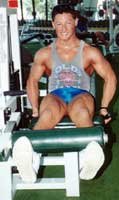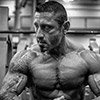Q. I just started training at a health club, and I'm confused. The free weights are in a different part of the club, and the guys down there talk about the people who train on machines like they're pansies. I don't want them to think I'm a pantywaist, but I like some of the machines. More importantly, which one is better for size, free weights or machines? I want to weigh 220 pounds, all muscle. Right now I'm 160.
Unsure,
Toledo, OH
A. It's one of bodybuilding's longest-running debates ever, and shows no signs of stopping. The free-weight versus machines argument really got its main thrust from the writings of Nautilus inventor Arthur Jones throughout the 1970's. Until then, machines were thought of a cute accessory to real weights - ie; free weights. Mr. Jones argued that his machines were actually superior to free weights, a theory so radical that its validity is still being argued today. Let's talk about free weights.
Since the turn of the century, the barbell and dumbbell have done more for building muscles than anything else before or since. Literally, millions of men and women have become big and strong through progressively adding resistance to bread-and-butter exercises like the bench press, squat, and deadlift, In fact, it's a safe bet that for 99 % of you reading this, the flat bench press was the very first exposure to weight training you had. There's no question that free weights work, and work well. From Eugene Sandow to Dorian Yates, heavy iron has been the ticket to a sensational body. But do free weights work perfectly? Not exactly.
The major limitation to barbells and dumbbells is that their line of resistance is always a straight vertical line - the pull of gravity. Whether you're curling, pressing overhead, rowing, or doing flyes, that iron is always being pulled straight down into the ground. In certain exercises, this presents no problem. Say you're squatting, for instance. The bar is on your back as you descend and rise, (theoretically) straight up and down. It's nearly a perfect movement. But what about those flyes? The motion of flyes involves lying on your back, bringing two dumbbells from a stretch position up into a contraction. If you were to draw the range of motion, you would see an arc for each arm. We know that gravity doesn't arc, it pulls in a perfectly straight line. So what? What this means is that only part of the flye - the part that crosses through that straight vertical line - receives proper resistance.
It's easier to observe with a barbell curl. Again you have an arc. When you start to curl the bar up from your waist, the resistance feels like nothing, even with a weight you can only manage 6-8 reps with. Quickly you encounter gravity's pull as the arc of motion hits the vertical plane. This "mid-point" of the curl is where most people struggle and get stuck. As you come near the top, you pass the vertical plane, and once again the resistance seems comically light. In essence, the first and last few inches range of motion were useless. In an arm training article I wrote for the December 1997 Ironman, I suggested eliminating these portions of the rep for better results. It should be apparent by now that certain free weight movements have their limitations. How are machines better?
The answer lies in the cam, or wheel. Arthur Jones was the first to develop the cam, that kidney bean-shaped apparatus that a chain or a belt could track over, effectively creating an evenly distributed resistance over the entire range of motion. This meant not only would you be able to have the weight remain constant, but you would also eliminate the sticking point. Applied to certain exercises, the effect was a vast improvement over their freeweight counterparts. The Nautilus Pullover was and still is many times more effective than the same motion performed with a barbell or dumbbell. But as revolutionary as Nautilus was, machines have gotten even better since the 70's.
One notable equipment line is Hammer Strength, designed by Arthur's son Gary Jones. Hammer Strength machines are plate loaded, which takes away some of the "machine" stigma, and are among the most effective pieces I have ever used. College and pro football strength coaches across America swear by them. A company called Strive has actually invented machines that allow you to selectively overload specific portions of the range of motion.
Two more factors in which machines are an improvement on free weights are safety and proper technique. Machines are usually self-spotting, meaning it would be fairly difficult to drop anything on yourself. How many times have you been stuck under a bar with no spotter? Once is enough, believe me. As far as technique, properly executed free-weight movements like the squat or row are excellent for building size and strength. Unfortunately, without proper instruction, which most people don't have, most people never "properly execute" very many free weight exercises.
I used to make it my personal mission to try and correct horrible form in the gym, but it was a thankless and ineffective battle. Most people will be able to leg press with decent form fairly quickly, but few gyms have more than a handful of trainers who can perform a squat in perfect form. While the squat may be a better exercise than the leg press, its advantages are lost on those who can not or will not perform it correctly. Rows are another exercise which precious few trainers ever do properly with free weights. So, you think that's it, eh? I've answered your question and steered you upstairs to the shiny machines for good? Not quite.
 If your goal is to build the best possible physique you can, you should use both free weights and machines. Certain movements lend themselves to free weights, some to machines. Be intelligent, experiment, and most of all pay attention to how each exercise feels in the target muscle. If you're not feeling it, your results will not be optimal. Use a mix of free weights and machines and you'll be on the fast track to 220. Choose one or the other, and you can hold off on buying that new extra large wardrobe. Below are what I have found to be the best exercises for various bodyparts, either with machines or free weights. Now have some strong coffee, slip on your headphones, and train your butt off!
If your goal is to build the best possible physique you can, you should use both free weights and machines. Certain movements lend themselves to free weights, some to machines. Be intelligent, experiment, and most of all pay attention to how each exercise feels in the target muscle. If you're not feeling it, your results will not be optimal. Use a mix of free weights and machines and you'll be on the fast track to 220. Choose one or the other, and you can hold off on buying that new extra large wardrobe. Below are what I have found to be the best exercises for various bodyparts, either with machines or free weights. Now have some strong coffee, slip on your headphones, and train your butt off!
| Best Free Weight Exercises | Best Machine Exercises |
| CHEST Dumbbell Bench Press Incline Dumbell Press |
CHEST Machine Flyes Hammer Strength Wide & Incline Bench Press |
| BACK Deadlifts Barbell Row Weighted Chins |
BACK Machine Pullover Hammer Strength Row (various types) Pulldowns |
| DELTS Seated Dumbbell Press |
DELTS Cable Side Laterals |
| LEGS Squats Stiff leg deadlift |
LEGS Leg Press or Hack Squat Leg Extension Leg Curl |
| BICEPS Barbell Curl Alternate Dumbbell Curl Preacher Curl |
BICEPS Hammer Strength Curl Cable Concentration Curl |
| TRICEPS Weighted Dips Close-Grip Bench Press Lying Tricep Extensions |
TRICEPS Hammer Strength Dips Smith Machine Close-Grip Press Pushdowns |
You may contact Ron Harris at www.ronharrismuscle.com.
